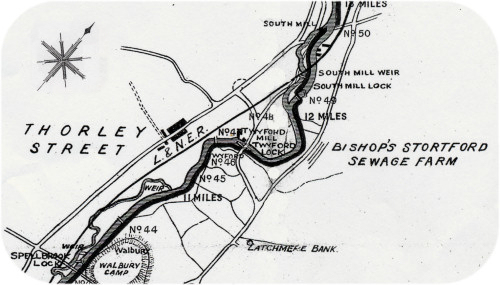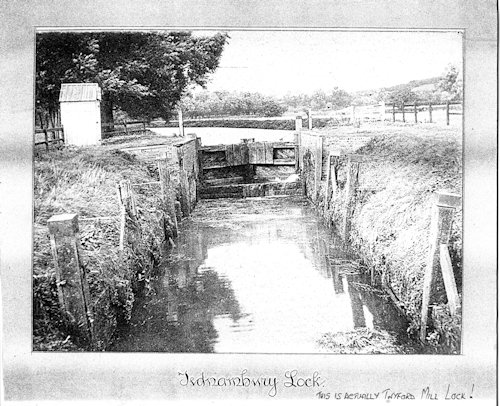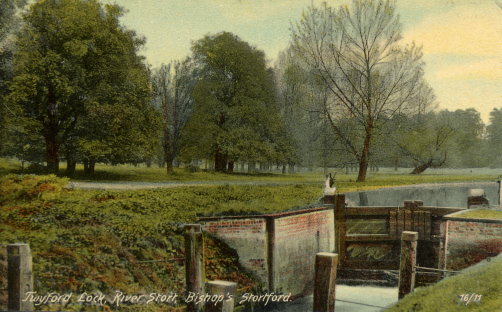|
TWYFORD LOCK
|
Lock |
State |
Date |
Length |
Length - Working Distance |
Width |
Fall |
|
Twyford Lock |
Built turfsided |
1766/9 |
90' 0'' |
87' 6'' |
13' 6'' |
7' 0'' |
|
Twyford Lock |
Rebuilt in brick/concrete |
1922 |
90' 0'' |
87' 6'' |
13' 6'' |
7' 0'' |

Griggs’ Report
1844: No 2 (No 46) Foot bridge called Rowley Croft is in good working order.*
No 14 Lock called Twyford Mills Lock is affected by a Mill; has a cart
bridge attached with 6 oak timbers and oak planking. Headway 5’ 9’’.
Depth of water on the lower sill 3’ 1’’; ditto on the upper sill 3’ 7’’;
the lower gates bad; dated 1812; This lock will in a short time require
repairing throughout.
* The footbridge
is now called the Rowley Croke, an interesting change in name over 170
years
Beardmore’s
Report 1870: Twyford Lock is in bad repair
Childs’ Report 1880:
Twyford; In bad condition generally, upper and lower gates very old.
Brickwork bad repair, side piles bad also. Fore bay good. Will require
an expenditure of £400 within a short time. Depths over sills
sufficient.
Childs'
1884 Report: ''In bad
condition generally, upper and lower gates very old, but in fair repair.
Brickwork bad repair, side piles bad also. Forebay good, will
require an expenditure of £400 within a short time, depth over sills
sufficient''
Tween's
1901 Report:
''In bad condition generally. Upper and lower gates very old, 1848.
Brickwork, bad repair, side piles bad also. will require an expenditure
of £500. (Both sills) should be lowered 1 foot''
The image below is from the 1901 Report

The name came from Twyford
Mill, derived from the two fords which were next to the mill, the Stort
and the Latchmer Brook, a small stream rising in Birchanger.
Records of a mill on the River Stort at Twyford go back
as far as the 1086 Domesday Book. By 1900, Twyford Mill was
converting farm produce such as grain, peas and beans into animal feed.
In 1909 the Lee Conservancy Board were in negotiations to
take over the Stort Navigation. As part of the new agreement they sought
to eliminate the millers' rights to tolls for traffic passing through
adjoining locks (6d). The Board also wanted to regulate a consistent and
overall 12" drop in water level as the boats passed through all their
rivers' locks. Three of the mills, including Twyford, held out for the
existing lesser 9" fall in level in order to maintain a higher constant
flow though their water wheels. The miller, Mr Lawrence, and the owner,
Mr Frere, were described in the transfer proceedings as being
'obdurate'. It took two more years of negotiation before an agreement
could be reached.
The Mill ceased operation in the late 1940's and was
later converted into residential accommodation.
In the 1970's a new spillway was built
above the lock on the towpath side as part of a flood relief scheme.

The turf sided lock
is pictured here on a card posted on July 13th 1913.
The head stream to the mill is just visible in front of the trees on the
left.
|

